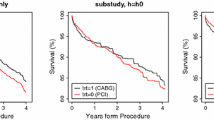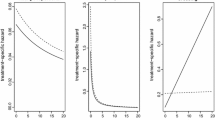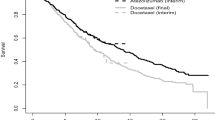Abstract
In randomized clinical trials, we are often concerned with comparing two-sample survival data. Although the log-rank test is usually suitable for this purpose, it may result in substantial power loss when the two groups have nonproportional hazards. In a more general class of survival models of Yang and Prentice (Biometrika 92:1–17, 2005), which includes the log-rank test as a special case, we improve model efficiency by incorporating auxiliary covariates that are correlated with the survival times. In a model-free form, we augment the estimating equation with auxiliary covariates, and establish the efficiency improvement using the semiparametric theories in Zhang et al. (Biometrics 64:707–715, 2008) and Lu and Tsiatis (Biometrics, 95:674–679, 2008). Under minimal assumptions, our approach produces an unbiased, asymptotically normal estimator with additional efficiency gain. Simulation studies and an application to a leukemia study show the satisfactory performance of the proposed method.
Similar content being viewed by others
References
Bagdonavicius V, Hafdi M, Nikulin M (2004) Analysis of survival data with cross-effects of survival functions. Biostatistics 5: 415–425
Bennet S (1983) Analysis of survival data by the proportional odds model. Stat Med 2: 273–277
Cox D (1972) Regression model and life-tables (with discussion). J R Stat Soc B 34: 187–220
Garbow B, Hillstrom K, More J (1980) Minpack project. Argonne National Laboratory, USA
Grouin JM, Day S, Lewis J (2004) Adjustment for baseline covariates: an Introductory Note. Stat Med 23: 697–699
Hauck WW, Anderson S, Marcus SM (1998) Should we adjust for covariates in nonlinear regression analyses of randomized trials?. Control Clin Trials 19: 249–256
Hess K (1994) Assessing time-by-covariate interactions in proportional hazards regression models using cubic spline functions. Stat Med 13: 1045–1062
Hsieh F (2001) On heteroscedastic hazards regression models: Theory and Application. J R Stat Soc B 63: 63–79
Koch GG, Tangen CM, Jung JW, Amara IA (1998) Issues for covariance analysis of dichotomous and ordered categorical data from randomized clinical trials and non-parametric strategies for addressing them. Stat Med 17: 1863–1892
Lesaffre E, Senn S (2003) A note on non-parametric ANCOVA for covariate adjustment in randomized clinical trials. Stat Med 22: 3586–3596
Lu X, Tsiatis A (2008) Improving the efficiency of the log-rank test using auxiliary covariates. Biometrika 95: 674–679
Robinson L, Jewell N (1991) Some surprising results about covariate adjustment in logistic regression models. Int Stat Rev 59(2): 227–240
Senn S (1989) Covariate imbalance and random allocation in clinical trials. Stat Med 8: 467–475
Singleton R (1969) Algorithm 347, an efficient algorithm for sorting with minimial storage. Commun ACM 12(3): 185–187
Tangen CM, Koch GG (1999) Nonparametric analysis of covariance for hypothesis testing with logrank and Wilcoxon scores and survival-rate estimation in a randomized clinical trial. J Biopharm Stat 9: 307–338
Tsiatis A (2006) Semiparametric theory and missing data. Springer, New York
Tsimberidou AM, O’Brien S, Khouri I, Giles F, Kantarjian H, Champlin R, Wen S, Do K, Smith S, Lerner S, Freireich E, Keating MJ (2006) Clinical outcomes and prognostic factors in patients with Richter’s Syndrome treated with chemotherapy or chemoimmunotherapy with or without stem-cell transplantation. J Clin Oncol 24: 2343–2351
Verweij J, van Houlwelingen H (1995) Time dependent effects of fixed covariates in Cox regression. Biometrics 51: 1550–1556
Wickramaratne P, Holford T (1989) Confounding in epidemiologic studies response. Biometrics 45: 1319–1322
Yang S, Prentice R (2005) Semiparametric analysis of short-term and long-term hazard ratios with two-sample survival data. Biometrika 92: 1–17
Zeng D, Lin D (2007) Maximum likelihood estimation in semiparametric models with censored data (with discussion). J R Stat Soc B 69: 507–564
Zhang M, Tsiatis A, Davidian M (2008) Improving efficiency of inferences in randomized clinical trials using auxiliary covariates. Biometrics 64: 707–715
Author information
Authors and Affiliations
Corresponding author
Rights and permissions
About this article
Cite this article
Garcia, T.P., Ma, Y. & Yin, G. Efficiency improvement in a class of survival models through model-free covariate incorporation. Lifetime Data Anal 17, 552–565 (2011). https://doi.org/10.1007/s10985-011-9195-z
Received:
Accepted:
Published:
Issue Date:
DOI: https://doi.org/10.1007/s10985-011-9195-z




